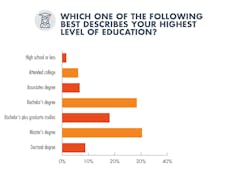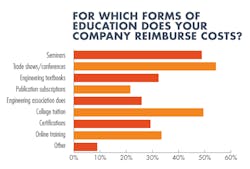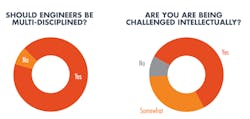“When you spend all your available time trying to put out today’s fires, it is difficult to do anything to prevent tomorrow’s fires.” That was how one respondent to Electronic Design’s engineering Salary Survey summarized the challenges he faces keeping up with the latest technologies and building them into products. But many of the other more than 1,300 respondents highlighted the same sorts of problems.
Balancing one’s personal and professional lives can be complicated when the average work week lasts around 50 hours, not including time on call. But carving out time for continuous education at the same time is an additional challenge, many electrical and electronics engineers say. “There is not enough time allotted for training. It always falls into the beyond 40 hours per week category,” one respondent bemoaned.
“The state of the art seems to change faster and faster with every passing day, while I seem to get slower and slower,” another respondent said.
Many others lamented having limited time for training and not having adequate support from shortsighted management. Some complained about the amount of time they waste sorting through datasheets, white papers, engineering forums, and other online resources. “The engineering landscape has become so broad that it is often difficult to pick and choose what to learn about given a limited amount of time,” said one respondent.
Despite the two-fifths of respondents who have given thought to moving onto less stressful or better paying jobs, career satisfaction remains high. More than 90% say that they feel intellectually challenged in their current positions. The challenges that accompany product design was the number one factor in job satisfaction over the last year, followed closely by researching potential design solutions, according to the survey.
Continuous education is part of the job description for many electrical and electronics engineers. Around 35% of respondents indicate that staying current with new technologies is the number one professional issue they lose sleep over—not looming project deadlines, not product reliability issues, not dealing with staff reductions. “We are expected to do more with less time so staying current means doing it off hours,” said one respondent.
Respondents say that employers have boosted total compensation, health coverage, retention bonuses, and other incentives over the last year to fill open engineering positions with more than journeymen and contractors. Two-thirds reported that their current companies are having trouble filling job openings. Employers could also offer to pay for training programs or other continuous education to sweeten the deal.
Engineering salaries continue to ramp up.The survey showed that the average salary is currently $113,624 versus $105,040 in 2017 and $97,644 in 2014. The average bonus amounts to $4,492 with a median of $3,000. Around 60% of respondents project that their total compensation will be higher than it was last year, while a little more than 30% say it will probably remain the same. Only 10% anticipate a decrease.
How employers respond could come down to the way they address higher turnover in the engineering profession.Survey respondents who have worked for their company for less than five years increased from 26% to 38% over the last half decade. And yet only around one-tenth are actively looking for new jobs. Nearly 32% indicated that they would listen if personally offered a position.
Some respondents feel that employers are unwilling to invest in training new electrical engineering hires. Others argue that the qualifications for many new jobs are unreasonably broad, giving companies ground to hire contractors or resort to outsourcing. One said: “In spite of my efforts I’m finding that I’m having to narrow my area of expertise more than I would I like” because there is not enough time to learn about new technologies.
“It is kind of like being a doctor,” said another respondent who develops industrial control software. “Are you a cardiologist or endocrinologist? Most people expect you to know everything in software, but you have to focus your time on staying current with whatever you have been employed for. For instance, I haven’t done much web development since 2005. So I’m somewhat behind on Ruby, Python and JavaScript.”
Download the full survey results as a .PDF.
The number of respondents who say an engineering shortage exists increased from 51% to 63% over the last year. “It is difficult to identify what might be the next most important skill required for me to stay relevant. Being on the older side, it can be challenge to figure out what skills I might need for my next job,” said a survey respondent. They noted that younger engineers have a better feel for current technology trends.
Employers are also reconsidering the types of continuous education that they will reimburse. Despite almost two-thirds of respondents saying that engineering students are not learning the necessary skills to succeed, companies seem to be keeping continuous education out of the workplace: Only around one-fifth of respondents use in-house training programs sponsored by their employers.
But their employers foot the bill for other forms of education. Around 49% say that they can be compensated for college tuition, up from around 46% in 2017 and 41% in 2014. Trade conferences are also important in the eyes of employers: While around 42% take time to network and educate themselves at conferences, 54% say that their company is willing to pay for their attendance.
Seminars, on the other hand, are starting to lose ground. About 58% say that they take advantage of seminars to stay knowledgeable, but less than half say that compensation is available, down from 55% in 2014. Conversely, compensation for engineering certifications has grown from 26% to 29% in the last five years. Engineering association dues are covered for around 26% of respondents.
The survey also showed that engineering professionals are increasingly using online resources to educate themselves. Use of online training has expanded from 27% to 33% of respondents over the last year, while more than a fourth of respondents say they take online college courses to stay knowledgeable. Online discussion forums are used by around 25%, up from 20% over the last half decade.
But having all that information available raises other challenges. Separating what is actually useful from what can be ignored can take a significant amount of time. “Frequently I’ll find a white paper published five years ago that would have helped me immeasurably with a project within the last five years,” one respondent explained.“Finding technical details as opposed to marketing fluff is always a challenge,” another added.
Another respondent pointed out the difficulty of telling “the difference between papers that are currently just research versus those that can be applied immediately to solving my design problems.” Others complained about struggling to make time for additional training and practice. Budgeting time for in-person training can be nearly impossible to balance with product deadlines at small companies, according to a number of respondents.
“My workload is excessive most of the time and it can be hard to find time for more training. Our company is small and people wear many hats to get the job done. So on-the-job training is abundant,” one survey respondent recalled. Some respondents say that online training is far from t ideal: “It is difficult to find hands-on in-person training. Sometimes that is just a better way to learn.”








